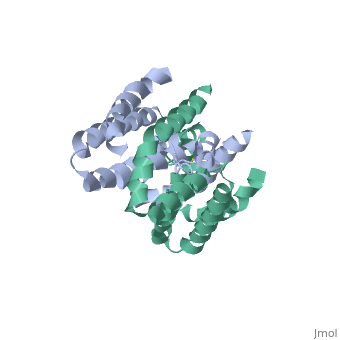2h24: Difference between revisions
No edit summary |
No edit summary |
||
| Line 3: | Line 3: | ||
<StructureSection load='2h24' size='340' side='right'caption='[[2h24]], [[Resolution|resolution]] 2.00Å' scene=''> | <StructureSection load='2h24' size='340' side='right'caption='[[2h24]], [[Resolution|resolution]] 2.00Å' scene=''> | ||
== Structural highlights == | == Structural highlights == | ||
<table><tr><td colspan='2'>[[2h24]] is a 1 chain structure with sequence from [ | <table><tr><td colspan='2'>[[2h24]] is a 1 chain structure with sequence from [https://en.wikipedia.org/wiki/Human Human]. Full crystallographic information is available from [http://oca.weizmann.ac.il/oca-bin/ocashort?id=2H24 OCA]. For a <b>guided tour on the structure components</b> use [https://proteopedia.org/fgij/fg.htm?mol=2H24 FirstGlance]. <br> | ||
</td></tr><tr id='related'><td class="sblockLbl"><b>[[Related_structure|Related:]]</b></td><td class="sblockDat">[[1inr|1inr]]</td></tr> | </td></tr><tr id='related'><td class="sblockLbl"><b>[[Related_structure|Related:]]</b></td><td class="sblockDat"><div style='overflow: auto; max-height: 3em;'>[[1inr|1inr]]</div></td></tr> | ||
<tr id='resources'><td class="sblockLbl"><b>Resources:</b></td><td class="sblockDat"><span class='plainlinks'>[ | <tr id='resources'><td class="sblockLbl"><b>Resources:</b></td><td class="sblockDat"><span class='plainlinks'>[https://proteopedia.org/fgij/fg.htm?mol=2h24 FirstGlance], [http://oca.weizmann.ac.il/oca-bin/ocaids?id=2h24 OCA], [https://pdbe.org/2h24 PDBe], [https://www.rcsb.org/pdb/explore.do?structureId=2h24 RCSB], [https://www.ebi.ac.uk/pdbsum/2h24 PDBsum], [https://prosat.h-its.org/prosat/prosatexe?pdbcode=2h24 ProSAT]</span></td></tr> | ||
</table> | </table> | ||
== Function == | == Function == | ||
[[ | [[https://www.uniprot.org/uniprot/IL10_HUMAN IL10_HUMAN]] Inhibits the synthesis of a number of cytokines, including IFN-gamma, IL-2, IL-3, TNF and GM-CSF produced by activated macrophages and by helper T-cells. | ||
== Evolutionary Conservation == | == Evolutionary Conservation == | ||
[[Image:Consurf_key_small.gif|200px|right]] | [[Image:Consurf_key_small.gif|200px|right]] | ||
Revision as of 14:04, 5 January 2022
Crystal structure of human IL-10Crystal structure of human IL-10
Structural highlights
Function[IL10_HUMAN] Inhibits the synthesis of a number of cytokines, including IFN-gamma, IL-2, IL-3, TNF and GM-CSF produced by activated macrophages and by helper T-cells. Evolutionary Conservation Check, as determined by ConSurfDB. You may read the explanation of the method and the full data available from ConSurf. Publication Abstract from PubMedInterleukin-10 receptor 2 (IL-10R2) is a critical component of the IL-10.IL-10R1.IL-10R2 complex which regulates IL-10-mediated immunomodulatory responses. The ternary IL-10 signaling complex is assembled in a sequential order with the IL-10.IL-10R1 interaction occurring first followed by engagement of the IL-10R2 chain. In this study we map the IL-10R2 binding site on IL-10 using surface plasmon resonance and cell-based assays. Critical IL-10R2 binding residues are located in helix A adjacent to the previously identified IL-10R1 recognition surface. Interestingly, IL-10R2 binding residues located in the N-terminal end of helix A exhibit large structural differences between unbound cIL-10 and cIL-10.IL-10R1 crystal structures. This suggests IL-10R1-induced conformational changes regulate IL-10R2 binding and assembly of the ternary IL-10.IL-10R1.IL-10R2 complex. The basic mechanistic features of the assembly process are likely shared by six additional class-2 cytokines (viral IL-10s, IL-22, IL-26, IL-28A, IL28B, and IL-29) to promote IL-10R2 binding to six additional receptor complexes. These studies highlight the importance of structure in regulating low affinity protein-protein interactions and IL-10 signal transduction. Conformational changes mediate interleukin-10 receptor 2 (IL-10R2) binding to IL-10 and assembly of the signaling complex.,Yoon SI, Logsdon NJ, Sheikh F, Donnelly RP, Walter MR J Biol Chem. 2006 Nov 17;281(46):35088-96. Epub 2006 Sep 18. PMID:16982608[1] From MEDLINE®/PubMed®, a database of the U.S. National Library of Medicine. See AlsoReferences
|
| ||||||||||||||||
